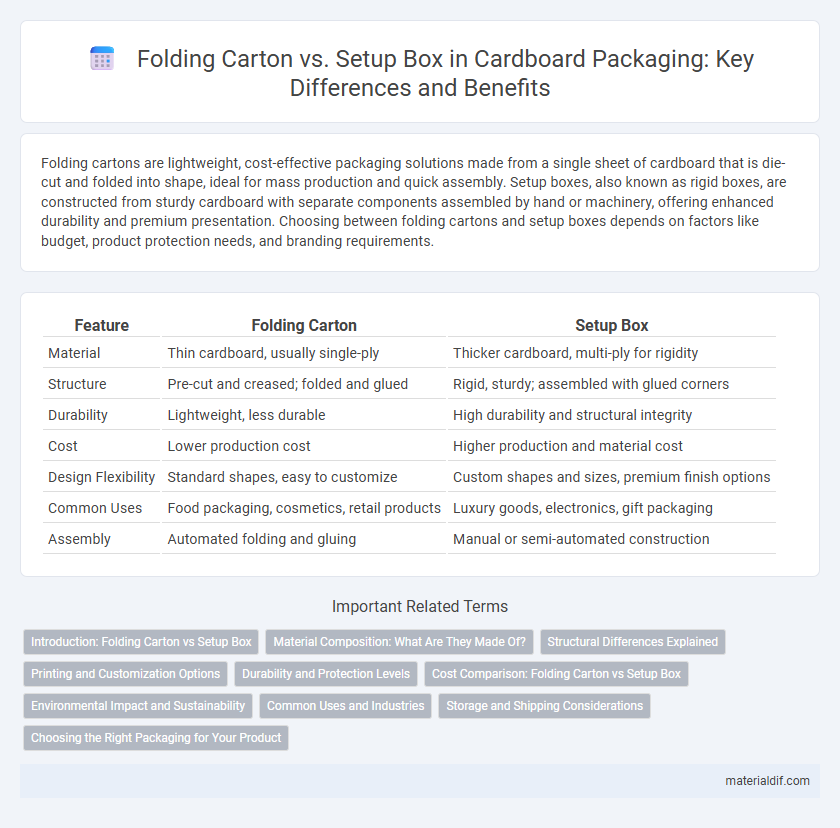Folding cartons are lightweight, cost-effective packaging solutions made from a single sheet of cardboard that is die-cut and folded into shape, ideal for mass production and quick assembly. Setup boxes, also known as rigid boxes, are constructed from sturdy cardboard with separate components assembled by hand or machinery, offering enhanced durability and premium presentation. Choosing between folding cartons and setup boxes depends on factors like budget, product protection needs, and branding requirements.
Table of Comparison
| Feature | Folding Carton | Setup Box |
|---|---|---|
| Material | Thin cardboard, usually single-ply | Thicker cardboard, multi-ply for rigidity |
| Structure | Pre-cut and creased; folded and glued | Rigid, sturdy; assembled with glued corners |
| Durability | Lightweight, less durable | High durability and structural integrity |
| Cost | Lower production cost | Higher production and material cost |
| Design Flexibility | Standard shapes, easy to customize | Custom shapes and sizes, premium finish options |
| Common Uses | Food packaging, cosmetics, retail products | Luxury goods, electronics, gift packaging |
| Assembly | Automated folding and gluing | Manual or semi-automated construction |
Introduction: Folding Carton vs Setup Box
Folding cartons are lightweight, cost-effective packaging solutions made from paperboard that can be easily folded into shape without adhesives, primarily used for retail products like cosmetics and pharmaceuticals. Setup boxes, made from rigid chipboard and covered with decorative paper or fabric, offer superior durability and premium presentation for luxury items such as jewelry and electronics. Understanding the differences in material strength and assembly methods is crucial for selecting the appropriate packaging that balances protection, aesthetics, and budget.
Material Composition: What Are They Made Of?
Folding cartons are primarily made from lightweight paperboard that is easily folded and creased for efficient packaging, often coated with a thin layer of plastic or a printed exterior for durability and branding. Setup boxes, on the other hand, use thicker, rigid cardboard or chipboard, providing a sturdy and solid structure, often lined with paper or fabric for enhanced aesthetic appeal and protection. The material composition of folding cartons emphasizes flexibility and cost-effectiveness, while setup boxes prioritize durability and premium feel due to their heavier, more rigid materials.
Structural Differences Explained
Folding cartons are made from a single sheet of cardboard that is die-cut and scored for easy folding into a box shape, offering lightweight and cost-effective packaging solutions. Setup boxes are constructed from rigid cardboard with separate components glued together, providing enhanced durability and a premium feel ideal for luxury products. The key structural difference lies in folding cartons being collapsible and less rigid, while setup boxes maintain a stiff form and often include reinforced edges for added strength.
Printing and Customization Options
Folding cartons offer high-quality digital and flexo printing with vibrant color options, making them ideal for detailed graphics and quick production runs. Setup boxes provide premium offset printing and advanced customization techniques such as embossing, foil stamping, and spot UV coating for a luxurious finish. Both packaging types accommodate custom designs, but setup boxes excel in intricate embellishments that enhance brand perception.
Durability and Protection Levels
Folding cartons offer moderate durability and protection, ideal for lightweight or less fragile products due to their flexible, foldable design made from single-piece cardboard. Setup boxes, constructed from rigid, thicker cardboard with reinforced edges and corners, provide superior structural integrity and high protection against physical damage, making them suitable for premium or delicate items. The choice between folding cartons and setup boxes depends on required strength, protection level, and product handling needs.
Cost Comparison: Folding Carton vs Setup Box
Folding cartons are generally more cost-effective due to their lightweight materials and efficient production process, making them ideal for high-volume packaging with lower per-unit costs. Setup boxes, constructed from rigid cardboard and requiring more labor, involve higher material and assembly expenses, resulting in a premium price point suited for luxury or specialty products. Budget considerations typically favor folding cartons for large-scale distribution, while setup boxes are chosen for brand differentiation despite increased costs.
Environmental Impact and Sustainability
Folding cartons typically use less material and require simpler manufacturing processes, resulting in a smaller carbon footprint compared to setup boxes, which involve more rigid materials and complex assembly. The recyclability of folding cartons is higher due to their thinner paperboard composition and minimal use of adhesives, enhancing sustainability efforts in packaging. Setup boxes, while offering superior durability, often challenge recycling systems and generate more waste, posing greater environmental concerns.
Common Uses and Industries
Folding cartons are widely used in the food, pharmaceutical, and consumer goods industries due to their cost-effectiveness and ease of assembly, making them ideal for packaging products like cereals, medicines, and cosmetics. Setup boxes, often found in luxury goods, electronics, and gift packaging sectors, provide sturdy construction and enhanced protection for items such as jewelry, electronics, and high-end perfumes. Both packaging types cater to different market demands, with folding cartons focusing on mass production and efficient logistics while setup boxes emphasize premium presentation and durability.
Storage and Shipping Considerations
Folding cartons offer space-efficient storage and shipping due to their flat, collapsible design, reducing warehouse and transport volume significantly. Setup boxes require more storage space because they are rigid and pre-assembled, leading to higher shipping costs and the need for protective handling. Optimizing packaging type depends on balancing storage constraints and transportation expenses within the supply chain.
Choosing the Right Packaging for Your Product
Folding cartons offer cost-effective, lightweight packaging ideal for high-volume products requiring quick assembly, while setup boxes provide sturdy, premium protection with rigid construction suited for luxury or fragile items. Consider product weight, presentation needs, and budget when choosing between folding cartons and setup boxes to ensure optimal brand appeal and functionality. Packaging durability, printing capabilities, and ease of customization are critical factors influencing the decision for effective product packaging.
Folding carton vs Setup box Infographic

 materialdif.com
materialdif.com